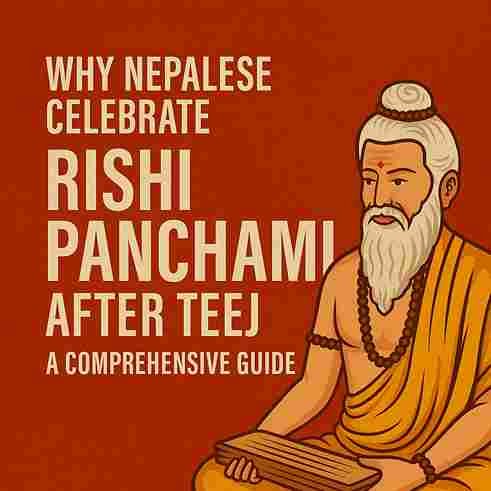Nepal, a land rich in traditions and rituals, celebrates a variety of Hindu festivals that blend spirituality, culture, and devotion. Among them, Rishi Panchami holds a special place, particularly for Hindu women. Celebrated immediately after Haritalika Teej, Rishi Panchami is a day of purification, penance, and homage to ancient sages (rishis). But why is it celebrated right after Teej? What is its significance?

Rishi Panchami After Teej
In this comprehensive blog, we explore the historical roots, cultural significance, rituals, and symbolic meaning of Rishi Panchami in Nepalese society, and why it follows the grand celebration of Teej.
What is Rishi Panchami?
Rishi Panchami is observed on the fifth day (Panchami) of the bright fortnight (Shukla Paksha) in the month of Bhadra (August–September). It is a traditional Hindu festival primarily celebrated by women as a day of ritual purification and atonement for sins committed during menstruation.
The word “Rishi” refers to ancient sages, and “Panchami” means the fifth lunar day. On this day, devotees worship seven sages (Saptarishi) Kashyapa, Atri, Bharadvaja, Vishwamitra, Gautama, Jamadagni, and Vashistha offering prayers for wisdom, purity, and spiritual liberation.
Why is Rishi Panchami Celebrated After Teej?
Teej is a vibrant and devotional festival dedicated to Goddess Parvati, where married and unmarried women fast and pray for marital happiness, the well-being of their husband, and future spouses. Teej includes three main days: Dar Khane Din (feast), Teej Vrat (fasting), and Rishi Panchami.
Rishi Panchami is not merely a follow-up to Teej, but an essential concluding ritual that cleanses the body and soul. It is believed that during Teej, women may have unknowingly violated traditional purity norms especially related to menstrual impurity, which is considered inauspicious in orthodox Hindu customs. Rishi Panchami provides a chance to cleanse these perceived spiritual lapses.
Symbolically:
- Teej represents devotion, love, and dedication.
- Rishi Panchami signifies purification, self-reflection, and respect to sages who gave moral and spiritual direction.
Thus, the two festivals, although different in mood and rituals, are interlinked spiritually and culturally.
The Mythological Story Behind Rishi Panchami
The observance of Rishi Panchami is based on an ancient story mentioned in Hindu scriptures like the Purana. According to the legend:
There was once a Brahmin family in which a woman died and was reborn as a dog due to her sins of not observing the proper ritual purification after menstruation. Her mother was deeply distressed and consulted a sage, who recommended that the daughter observe Rishi Panchami vrat in her next birth. When she did, she was freed from the cycle of rebirth.
This story underscores the belief in karma, atonement, and the importance of observing dharma. It promotes the idea that rituals like Rishi Panchami can purify one’s soul from past mistakes.
Rituals of Rishi Panchami in Nepal
Rishi Panchami is widely observed in both urban and rural areas of Nepal, especially in Hindu communities. Here are the major rituals performed:
1. Morning Purification Bath
Women wake up early and take a bath using datiwan (herbal bush), mud, and cow dung, which are believed to purify the body and remove sins.
2. Fasting (Vrat)
Women observe a strict fast on this day no grains, salt, or lentils are consumed. Fruits, roots, and pure foods are allowed.
3. Worship of Saptarishi and Deities
A symbolic image or idol of the Seven Rishis is placed and worshipped. Offerings include:
- Flowers
- Fruits
- Incense
- Lamps
- Sacred water
Goddess Arundhati, the wife of Sage Vashistha, is also worshipped as a symbol of chastity and devotion.
4. Donation and Charity
Charity is considered meritorious on this day. Women donate food, clothes, and money to Brahmins or needy people.
Regional Variations and Social Beliefs
- In many parts of rural Nepal, women perform rituals in nearby rivers or ponds, believing that bathing in natural water sources enhances spiritual cleansing.
- Some communities organize group rituals, making it a collective social and religious experience.
- Mothers often pass down these rituals to daughters, reinforcing traditional values and generational continuity.
While the religious importance remains, younger generations of Nepalese women are also interpreting the ritual in more symbolic and personal ways. Many see Rishi Panchami as:
- A day of self-care and reflection
- A reminder of respecting feminine cycles, rather than labeling them impure
- A chance to connect with cultural roots while being mindful of evolving values
Some urban families are now modernizing the observance, focusing more on intention and devotion rather than strict rules.
Rishi Panchami is a significant festival in Nepalese Hindu culture, especially for women. It acts as a spiritual cleanser that follows the intense devotion of Teej. While it originates from orthodox customs, its underlying message of honoring sages, seeking forgiveness, and striving for purity holds timeless relevance.
Celebrating Rishi Panchami after Teej completes a cycle of devotion, discipline, and purification. Whether practiced traditionally or interpreted spiritually, the festival continues to be a unique part of Nepal’s cultural identity.


